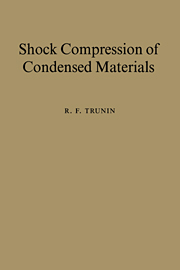3 - Shock compression of metals
Published online by Cambridge University Press: 03 December 2009
Summary
Absolute laboratory measurements of kinematic parameters
Shock compression of about sixty metals of the periodic system, i.e., of the majority of metals, has been studied over various ranges of pressure.
The reported maximum pressures achieved in laboratory conditions are 1.8 TPa for iron, 1.0 TPa for aluminum, 2.5 TPa for tantalum, 1.3 TPa for titanium, and 2.1 for molybdenum [30, 31]. More than ten metals have been studied under pressures of up to 1.0 TPa, the rest of them, depending on their initial density, have been tested in a range of 60 GPa (lithium) to 500 GPa (tungsten) [32].
Let us recall that the parameters directly measured in dynamic experiments are the shock velocity D and the particle velocity U behind the shock front. The thermodynamic parameters, such as pressure, compression, and energy are derived using conservation equations, and the temperature is derived using the equation of state. We shall analyze most of the experimental data in terms of the directly measured parameters D and U.
A remarkable feature of Hugoniots plotted in D – U coordinates is the linear or close to linear dependence between these parameters in fairly wide ranges of parameters. This linearity between the shock velocity and particle velocity in certain ranges of these parameters has not been proved theoretically, but was observed in hundreds of experiments with various materials ranging from gases to solids in their initial states. Certainly, this statement is an approximation to the real state of things and, to some extent, depends on the measurement accuracy of shock parameters and density of experimental points on the plots.
- Type
- Chapter
- Information
- Shock Compression of Condensed Materials , pp. 25 - 94Publisher: Cambridge University PressPrint publication year: 1998



